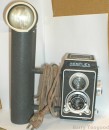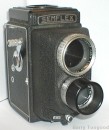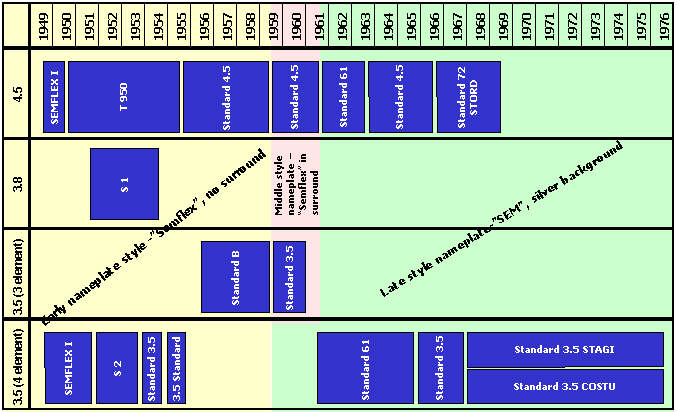.JPG)
Alsaphot Bioflex
A rare and stylish variant on the TLR concept - very French and rather different. This is the Model 1 Type 2. Several advanced capabilities include full automatic shutter cocking; extending crank handle (set in a large styled knob); aperture and speed settings through geared lens surrounds, but focus via Rollei-style side knob, etc. The lenses are giant f2.9 Sagem Jaguars, made by France's pre-eminent optical supplier.
Sales seem to have been the problem, perhaps because all of these special features must have made the Bioflex very pricy!
Taking lens Sagem Jaguar 75mm f2.9
Prontor-SV Shutter 1 to 1/300
|

Cornu Ontoflex
Unusual 1930s giant TLR taking 6x9 pictures on 120 film. The film back rotates to provide alternative orientations for landscape and portrait. This is a Model A (rollfilm only). The Cornu company, like Franke and Heidecke, went from making stereo cameras to TLRs, but the Ontoflex never sold in any quantity, proving rather an expensive cul-de-sac in camera development, like the German folding TLRs (q.v.).
Cornu made basic 35mm models during the German occupation in WW2, and seems to have abandoned cameras sometime soon after the war ended.
Taking lens Zeiss Tessar 75mm f3.5
Compur Rapid Shutter 1 to 1/400
|

Mecaoptic Celtaflex Model 2
As early as 1944, when France was still occupied, a chap called M. Bernard, a Paris photographer, founded Photoelec to make cameras, enlargers and other photo gear. The company made a rather basic but neat TLR called the Cameraflex, distributed by the firm of Marcel Halbout from 1947, who subsequently bought the product rights and relaunched the it as the first Celtaflex. Subsequently, manufacture moved to Mecaoptic-Photo, makers of various TLRs and other cameras into the early 'fifties. The one here is a second version dating from some time after the end of 1947.
The film insertion and winding mechanism is primitive, but functional. On the linked page (click the small photo above) can be seen the side view of this. However, the camera is very solid despite its near-diamond-jubilee age, and looks to have years of life left in it. The shutter is a fairly well-specified one from FAP, which is little stiff on slower speeds.
Taking lens Boyr Saphir 1 75mm f4.5
Shutter FAP Rapid-Synchro-OO 1 to 1/500
|

Royer Royflex I
The first Royflex model (this one is an early one with serial 2798) uses much of the design of the late Rex Reflex, with the same body moulding and sportsfinder lid. However, the frontal design has changed significantly, with the gearing between the lenses now concealed in the font panel and focusing by a round push-knob attached to the lower lens. It's a neat design, showing some quality improvements in the detailing and definite signs of a serious attempt at competing with the Rollei models. The model was followed by the evolving Royflex II and III series.
Lens SOM Berthiot Anastigmat 75mm f4.5
Shutter apparently Royer 1/10 to 1/350.
|

Royer Royflex III
When Royer launched the "new" Royflexes in 1954, the model III was the most radical (and much the most expensive), becoming the flagship of the range. It (like Alsaphot's Bioflex) attempted to carry battle direct to Rolleiflex, with crank winding and automatic arming of the shutter. It is a sophisticated design, seemingly solid, although it certainly never acquired the engineering cachet of the Rolleis. One would suspect that a hard-working professional would not find this early model attractive by comparison; the winding mechanism is stiff and feels less than totally developed. In 1956, the range was redeveloped somewhat with a new "Telelight" hood - see my notes below on the Royflex 20.
Lens SOM Berthiot Flor 75mm f3.5
Shutter apparently Royer 1 to 1/350
|

SEM Semflex Standard
T950 Type 2
Early 1950s model (1950-55). Basic camera with fairly limited capabilities and a range of very similar variants. The second of the basic 4.5 lens models.
Lens SOM Berthiot Anastigmat 75mm f4.5
Shutter OREC 10 to 1/250.
|

Semflex Standard T950
Type 2 variant
Same as previous one (slightly earlier) but with an unusual add-on two-part pull-up sport finder. This isn't listed by Hervé Pont and may be an aftermarket item.
Lens SOM Berthiot Anastigmat 75mm f4.5
Shutter OREC 10 to 1/250.
|

Semflex Standard 3.5B
(Type 9)
Several Semflex Standard variants exist. This is a 1955-59 3.5 model with the 3-element Berthiot lens. Fitted here with Semflex orange filter. Note how the appearance differs from the next camera (an earlier Type 13) shown. Around 1955, SEM made the appearance of the Semflex much fussier, with added silver/aluminium exposed. Personally, I don't consider that an improvement!
Taking lens is SOM Berthiot 75mm f3.5.
Shutter unnamed 1 to 1/400.
|

Semflex Standard
(Type 13) 3.5 (early)
A very nice example of the black-front Type 13 from 1953/4. The third model from the series with the better-quality 4-element Flor lens as standard. This differs from the version of the Type 13 shown in Hervy-Pont by lacking a synch connector to the right side of the lensboard. It's numbered very early in the Type 13 series (around the eightieth made), and I think it was made using remaining lensboard stock from the Type 12 production.
Lens SOM Berthiot Flor 75mm f3.5
Shutter unnamed 1 to 1/400
|
.JPG)
Semflex Standard 61
Type 15 3.5
Later model (1959-64) with grey covering and stylised brass-letter nameplate - little changed underneath! These models had the later 4-element Flor lens as standard.
Lens SOM Berthiot Flor 75mm f3.5
Shutter unnamed 1 to 1/400
|

Semflex Standard 61
(Type 15) 4.5
The same later model (1961-63) as the previous one, but a cheaper version with the older 4.5 3-element lens only. Grey matt paint and black leathercloth finish.
Lens SOM Berthiot Flor 75mm f3.5
Shutter unnamed 1 to 1/400.
|

Semflash 4.5 model 2
Unusual camera with permanently-attached electric flash, designed only for flash mode, with a fixed-speed shutter (possibly the same one as used on the Joie de Vivre (see next). Shutter and flash areautocoupled on this second version, esigned for studio portrait professionals.
Taking lens is SOM Berthiot 75mm f4.5.
Sem Aurec shutter (1/50?)
|

SEM Semflex Joie de Vivre 3.5
There are two Joie de Vivre models - this is the earlier, better one of 1956-60. Basic TLR, with five apertures set by symbols and one shutter speed. Sold as a luxury model (Tessar-type 4-element lens) but simple controls. Not a success - for the money, buyers wanted more "bells and whistles"!
Taking lens Som Berthiot Flor 75mm f3.5
Shutter unknown/basic - set at 1/50
|

Semflex Oto II (Type 21)
The "Otos" were SEM's Rolleiflex, just as the Semflex Standards were its equivalent to the Rolleicord range. They had a short-stroke wind-and-cock lever, but are otherwise very similar to contemporary Standard models. ("Oto" = Auto). This is the earliest version with the hinged wind-handle knob (c.1950). It may have been modified at some point to solder up the eye-level finder hatch in the lid, or this might be a factory mdification (unlikely).
Taking lens Som Berthiot Flor 75mm f3.5
Shutter OREC 1 to 1/400
|

Semflex Oto 3.5B (Type 30)
This is a later model of the Oto series, dating from around 1955-59, according to Hervé Pont. Interestingly, although several years later than the previous example, this model has advanced little in terms of its basic capability - lens and shutter. The Oto is a nice camera to use, with a good feel.
Taking lens Som Berthiot Flor 75mm f3.5
Shutter OREC 1 to 1/400
|

Semflex Oto 3.5 (Type 24)
This Oto is a Model 154 Type 24, as classified by Hervé-Pont. It has the serrated lens surround which first appeared around 1954 and is also found on the contemporary Standard model. This particular camera is a nicely preserved example, sourced from Marseilles area.
Taking lens Som Berthiot Flor 75mm f3.5
Shutter OREC 1 to 1/400
|

Semflex Oto 3.5 (Type 31)
This Oto is a Type 31, (1959-66) as classified by Hervé-Pont. It is distinguished first by the later grey plastic covering and stylised "SEM" nameplate used towards the end of the production run. The B series ahd auto-coupled shutter cocking on the crank wind.
Taking lens Som Berthiot Flor 75mm f3.5
Shutter OREC 1 to 1/400
|

SEM Semflex Oto Studio 1
SEM beat the Tele Rolleiflex to market by several years with this basic design for portrait use. There are altogether twelve variant models, falling into two main versions - Standard and Oto. This one is the better Oto (with Auto film wind by lever) in a middle period version (1959-62).
Lens SOM Berthiot Tele 150mm f5.4
Shutter OREC, 1 to 1/400 - set by turning the top lens
|

